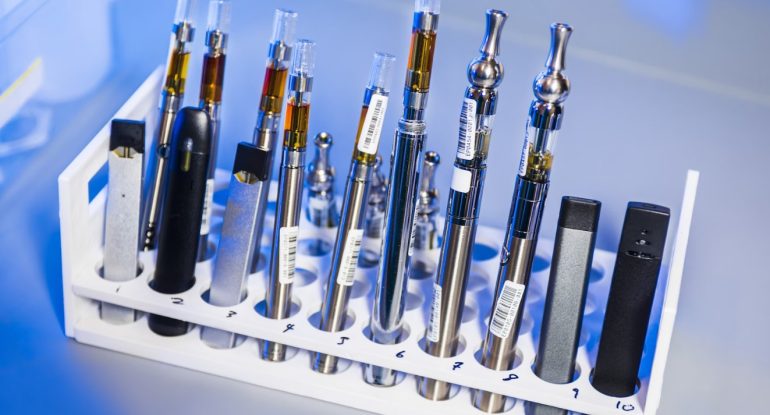As the popularity of THC vape pens continues to soar, both for recreational and medicinal purposes, a common question arises: Do these devices emit a smell, and if so, what influences it? Understanding the factors that determine the odor of THC vape pens is crucial for consumers seeking discretion without compromising on the quality of their experience.
This article delves into the multifaceted aspects that influence the smell of THC vape pens, providing insight for those looking to make informed decisions. We recommend you to buy the best THC vape pens from Exhale’s official link.
1. Type of THC Product
The base product used in the vape pen significantly impacts the scent it produces. Vape pens can utilize various forms of THC, including:
- Delta-9 THC: The most potent form, known for its strong psychoactive effects, tends to produce a more noticeable marijuana scent when vaporized.
- Delta-8 THC: A milder cousin of Delta-9, Delta-8 emits a less potent aroma, making it a preferred choice for users seeking discretion.
- Broad-Spectrum THC: These products may contain multiple cannabinoids but with minimal to no Delta-9 THC, affecting the scent profile to be less cannabis-like and more akin to the other terpenes present.
2. Terpenes
Terpenes are aromatic compounds found in cannabis and other plants. They play a significant role in determining the vape pen’s smell. Each terpene has a unique scent, from piney and earthy to citrusy and floral. Vape pens with high terpene content will produce a more distinct and potentially more pleasant aroma compared to those with lower terpene levels.
3. Quality of Ingredients
The purity and quality of the ingredients in the vape juice are paramount in determining the smell. High-quality, natural ingredients tend to produce a cleaner and less obtrusive scent. In contrast, lower-quality products or those with artificial additives and flavors can result in an unnatural and sometimes unpleasant odor.
4. Vaporizer Technology
The technology behind the vape pen itself, including the heating element (coil) and temperature settings, can alter the intensity and character of the scent. Lower temperatures tend to vaporize terpenes without burning them, preserving their aroma without producing a strong burnt scent.
Conversely, higher temperatures may degrade terpenes and other compounds, resulting in a harsher smell.
5. Environment and Ventilation
The environment in which the vape pen is used plays a role in how perceivable the smell is. Outdoor use typically results in the scent dissipating quickly, whereas indoor use, especially in poorly ventilated spaces, can allow the odor to linger and become more noticeable.
6. User’s Sensitivity to Smells
Individual sensitivity to smells can also affect how strong or noticeable the odor from a THC vape pen is perceived. What might be subtle to one person could be quite pronounced to another, influenced by factors such as individual olfactory sensitivity and familiarity with cannabis scents.
7. Legal and Social Considerations
The legal status of THC in your region might not directly affect the smell of vape pens but certainly influences consumer behavior regarding odor discretion. In areas where cannabis use is restricted or stigmatized, users might be more inclined to choose products and devices that minimize the scent.
8. Storage and Handling
The way a THC vape pen is stored and handled can impact the scent it emits during use. Exposure to high temperatures, direct sunlight, or air can degrade the THC oil, leading to changes in its chemical composition.
This degradation can not only affect the potency and flavor but also potentially alter the scent profile, making it more noticeable. Proper storage in cool, dark places can help preserve the integrity of the vape oil and maintain a more consistent scent experience.
9. Brand and Manufacturing Processes
The brand and its manufacturing processes play a crucial role in determining the odor of THC vape pens. Brands that invest in high-quality extraction and purification processes tend to produce oils that are purer and emit a less pungent aroma.
Additionally, some brands may incorporate filtration techniques designed to minimize the scent of their products, catering to users seeking a more discreet vaping experience.
10. Product Formulation
The specific formulation of the THC oil, including the ratio of cannabinoids to terpenes and the presence of any flavorings or additives, significantly influences its smell.
Formulations that mimic the natural terpene profile of cannabis strains can offer a more authentic and sometimes stronger scent, while those designed for discretion may minimize terpene content or use neutral-smelling additives to mask the cannabis odor.
Conclusion
The smell of THC vape pens is determined by a complex interplay of factors, from the type of THC product used and the presence of terpenes to the quality of ingredients and the technology of the vape pen itself.
For those seeking discretion, opting for vape pens with mild scents, such as those high in CBD or Delta-8 THC, and paying attention to product quality and vaping environment can make a significant difference. As the market continues to evolve, so does the technology and formulation behind vape pens, offering consumers an ever-growing array of options to suit their preferences and needs.











